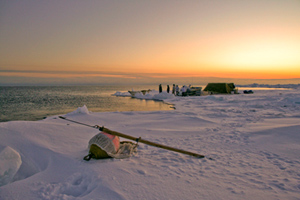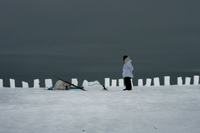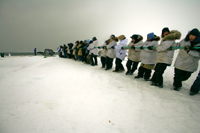- BEGIN THE WHALE HUNT
- statement
- highlights
- interface
- credits
- faq

Harpoon station at sunset in whaling camp
The Whale Hunt is an experiment in human storytelling.
In May 2007, I spent nine days living with a family of Inupiat Eskimos in Barrow, Alaska, the northernmost settlement in the United States. The first several days were spent in the village of Barrow, exploring ramshackle structures, buying gear, and otherwise helping the whaling crew to prepare for the hunt. We then traveled by snowmobile out onto the frozen Arctic Ocean, where we camped three miles from shore on thick pack ice, pitching our tents about ten feet from the open water. Boats were readied, harpoons prepared, whaling guns loaded, white tunics donned, a snow fence constructed, and then we sat silently in the -22 °F air, in constant daylight, waiting for whales to appear.

Howard readies a harpoon
A thousand-year-old tradition, the Inupiat whale hunt provides the community’s annual food supply, currently limited by international law to 22 whales a year. Each spring as the ocean thaws, ice breaks away from the mainland as a single massive chunk, which then floats out to sea, creating a canal of open water called the "lead". It is through this lead that Bowhead whales migrate north to the Arctic Circle, where they spend summers, surfacing for air every 30-45 minutes en route. We saw hundreds of whales on the horizon, but most were too far away to attack. Finally on the fourth day two whales (each 36 feet long and weighing around 40 tons) were harpooned, hauled up onto the ice using a block and tackle system that resembles a giant tug of war between man and sea, and summarily butchered, the meat and blubber then distributed to the Barrow community.

Simeon stands at the snow fence
The purpose of this project was threefold:

Hauling up a 36 foot Bowhead

Harvesting the whale
Third, to take an epic personal experience from the physical world and translate it optimally to the Internet, so that many people can share it.
I am grateful to Andrew Moore, a New York based friend and photographer who accompanied me on the trip, and to the Patkotak family of Barrow, Alaska, for their generosity in welcoming us into their house and later into their whaling camp. The Whale Hunt is really their story.
- Jonathan Harris, October 2007